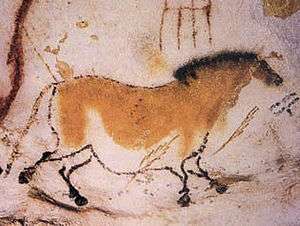Ochroconis anomala
| Ochroconis anomala | |
|---|---|
| Scientific classification | |
| Kingdom: | Fungi |
| Division: | Ascomycota |
| Order: | Incertae sedis |
| Family: | Incertae sedis |
| Genus: | Ochroconis |
| Species: | O. anomala |
| Binomial name | |
| Ochroconis anomala A.Nováková & P.M.Martin-Sanchez (2012) | |
Ochroconis anomala is a species of fungus of the Ascomycota group described in 2012. It was isolated from the black stains that appeared on the walls of Lascaux Cave in France. The species was discovered along with a closely related O. lascauxensis.[1] The species are regarded as a threat to the prehistoric paintings of the cave.[2]
The fungus was honoured as one of the "Top 10 New Species" discovered in 2012 selected by the International Institute for Species Exploration at Arizona State University among more than 140 nominated species. The uniqueness is its recent emergence and serious threat to the cave painting. The selection was declared on 22 May 2013.[3][4][5]
Discovery and description

The Lascaux Cave is a UNESCO World Heritage Site containing an Upper Paleolithic paintings that are about 17,000 years old. The cave wall was extensively defaced by an outbreak of a white mould Fusarium solani in 2001. The fungus was considered to have been present in the cave soil, and became exposed and spread particularly by the workers.[6] The invasive species was immediately treated with quicklime and complete control was achieved only in 2004, after regular treatment for three years. Surprisingly, only after four months of initial biocide treatment in 2001, among the white mould appeared some conspicuous black stains, which progressively disseminated on the walls and ceiling of the cave. These black stains were so prominent by 2007 that they became the cave's major problems and threat to the loss of the prehistoric art.[7] The human-pathogenic fungal community was rapidly spreading, mostly due the cave arthropods.[8] Biocides were again applied since January 2008, but were not effective in annihilating the new fungi; on the contrary, they appeared to increase the fungal diversity. This was obvious because the microbial analysis in 2010 revealed completely different fungal communities.[9] Mycological study in 2012 revealed that the black stains of the cave consisted of two species of fungi belonging to Ochroconis which are not human-pathogenic. Based on morphological and molecular description, the species were named Ochroconis lascauxensis and O. anomala. The spores of O. anomala are elliptical in shape and about 5–8 μm long. The species description was based on the phylogenetic comparison of the transcribed spacer (ITS) and RNA polymerase II subunit B (RPB2) using maximum likelihood method and by applying the Hasegawa–Kishino–Yano model based on a comparison of 1,062 nucleotides. In addition, the cellular fatty acid profiles showed that the development of these species was likely linked to the presence of unusual carbon and nitrogen organic sources provided by the intensive biocide application.[1]
Significance
Ochroconis anomala is a major concern for the conservation of precious rock art at Lascaux. It may eventually lead to complete destruction of the prehistoric painting and abrogation of the cave as an international heritage. The fungus is potentially harmless to human health.[10][11]
References
- 1 2 Martin-Sanchez PM, Nováková A, Bastian F, Alabouvette C, Saiz-Jimenez C (2012). "Two new species of the genus Ochroconis, O. lascauxensis and O. anomala isolated from black stains in Lascaux Cave, France". Fungal Biology 116 (5): 574–589. doi:10.1016/j.funbio.2012.02.006. PMID 22559918.
- ↑ Dixon B (March 2013). "Ongoing research is revealing unexpected facets of fungal damage to ancient paintings on the walls of caves in France and Spain". Microbe Magazine. American Society for Microbiology. Retrieved 2013-05-23.
- ↑ Newswise (22 May 2013). "Scientists Announce Top 10 New Species". Arizona State University College of Liberal Arts and Sciences. Newswise, Inc. Retrieved 2013-05-23.
- ↑ Arizona State University College of Liberal Arts and Sciences (22 May 2013). "Top 10 new species of 2012". ScienceDaily. ScienceDaily, LLC. Retrieved 2013-05-23.
- ↑ Varma S (23 May 2013). "Amazing top 10 new species include glowing cockroach, tiniest vertebrate and new monkey". The Times of India. Bennett, Coleman & Co. Ltd. Retrieved 2013-05-24.
- ↑ Dupont J, Jacquet C, Dennetière B, Lacoste S (2007). "Invasion of the French Paleolithic painted cave of Lascaux by members of the Fusarium solani species complex". Mycologia 99 (4): 526–533. doi:10.3852/mycologia.99.4.526. PMID 18065003.
- ↑ Bastian F, Jurado V, Nováková A, Alabouvette C, Saiz-Jimenez C (2010). "The microbiology of Lascaux Cave". Microbiology 156 (Pt. 3): 644–652. doi:10.1099/mic.0.036160-0. PMID 20056706.
- ↑ Bastian F, Alabouvette C, Saiz-Jimenez C (2009). "The impact of arthropods on fungal community structure in Lascaux Cave". Journal of Applied Microbiology 106 (5): 1456–1462. doi:10.1111/j.1365-2672.2008.04121.x. PMID 19210566.
- ↑ Martin-Sanchez PM, Nováková A, Bastian F, Alabouvette C, Saiz-Jimenez C (2012). "Use of biocides for the control of fungal outbreaks in subterranean environments: the case of the Lascaux Cave in France". Environmental Science & Technology 46 (7): 3762–3770. doi:10.1021/es2040625. PMID 22380699.
- ↑ Koebler J (23 May 2013). "Meet the 10 Coolest New Species Discovered in 2012". usnews.com. U.S.News & World Report LP. Retrieved 2013-05-24.
- ↑ Vincent J (23 May 2013). "Arizona University unveils the top 10 species discovered in 2012". The Independent. Retrieved 2013-05-24.
External links
- Molecular data at UniProt
- Classification at Encyclopedia of Life
- Classification at INPN
- CNET: The top 10 new species discovered in 2012
- Top Ten New Species distribution map
- National Geographic: Pictures: Top 10 Newly Discovered Species of 2012
- LiveScience: Top Ten New Species
- Top 10 Species Gallery